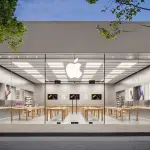With iOS 26, Apple Music users can tap album artwork on the Lock Screen to expand it into a moving, full-screen display. When a track includes animated visuals, the artwork springs to life in real time. Consequently, the Lock Screen no longer feels like a static pause; it reacts to the music playing. Meanwhile, music controls float translucently over the animation for quick access.
Liquid Glass Design Unveiled
This update marks the debut of Apple’s Liquid Glass interface across iOS 26. The company layers depth, color, and motion throughout the system, from Control Center to widgets. As a result, buttons and panels feel more like interactive surfaces than flat icons. Moreover, this aesthetic shift aims to make the phone’s interface appear more alive, without overwhelming users.

Device Support and Release Timeline
Animated artwork requires an iPhone with an A13 Bionic chip or later. Therefore, iPhone 11 and newer models will display moving covers. Apple rolled out the developer beta on June 10 and plans a public beta in July. Finally, the full release will arrive in fall 2025 as part of the standard iOS 26 update.
Beyond Apple Music: Third-Party Potential
Although Apple Music stands alone in offering animated art initially, Apple has released developer APIs to enable broader support. Consequently, apps like Spotify or Tidal could adopt moving visuals if developers choose to integrate them. However, third-party adoption will depend on demand and development priorities.
User Impact and Battery Considerations
For most listeners, these animations will add flair without altering playback. However, some users may question the feature’s effect on battery life. Based on past updates, Apple will likely include a toggle to disable animations. Ultimately, while the change remains cosmetic, it signals a larger push toward responsive, immersive interfaces in iOS.












